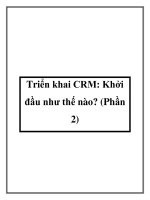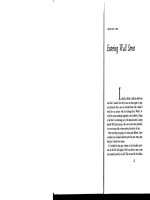ACCA Burying the Billable Hour phần 2 pdf
Bạn đang xem bản rút gọn của tài liệu. Xem và tải ngay bản đầy đủ của tài liệu tại đây (79.99 KB, 10 trang )
1% The customer dies.
3% The customer moves away.
5% The customer has a friend.
9% The customer is lost to a
competitor.
14% The customer is dissatisfied
with the service.
68% The customer believes you
dont care about them.
What about the opposite side of
the same coin, that is, what
characteristics do customers use to
select an accountant? According to
William J. Winston in Marketing
for CPAs, Accountants, and Tax
Professionals (1995: 170):
interpersonal skills
aggressiveness
interest in the customer
ability to explain procedures in
terms the customer can
understand
willingness to give advice
perceived honesty.
What is conspicuously missing
from these surveys? Price. It
doesnt even show up. Most
defections from accounting firms
are the result of human failings,
and perceptions of indifference,
rather than price or technical
quality. In other words, it is how
people are treated or mistreated
that determines their willingness
to remain loyal.
Further empirical evidence of price
insensitivity or what economists
call price inelasticity is observed
when the average accounting firm
increases its prices, revenues
increase. Or, put another way,
what would happen to the gross
revenue in your firm if you cut
prices by one half? My conjecture
is your gross revenue would
decrease, not increase. If
accountants truly operated in a
price-sensitive market, we would
observe the opposite results in
both of these examples.
You are what you charge for. And
you will never receive more than
you think you are worth. If you
dont believe you are worth
multiples of your (arbitrary) hourly
rate, neither will your customers.
The accounting profession needs to
restore pricing to its exalted
PAGE 9
You are what you charge for (continued)
position in the four Ps of
marketing. For too long we have
let our price be largely or solely
determined by the antiquated
billable hour paradigm, or by our
competitors. I have dedicated my
life to a solitary mission: to bury,
once and for all, the billable hour.
It is a mission I take very seriously,
and my goal in this booklet is not
to have you think like me, but to
think with me. It is time for this
profession to begin to price on
purpose. In order to accomplish
that goal, it is necessary to
understand the correct theory of
value, which we will now examine.
PAGE 10
You are what you charge for (continued)
The above quote from Karl Marx
has obvious appeal to young
revolutionaries who set out to
remake the world in their image.
But as any serious social scientist,
economist, psychiatrist or other
student of human behaviour will
tell you, before you can change
the world, you must first
understand it. Understanding
human behaviour is, in itself, a
Herculean task. To understand the
dynamics of a profession is just as
daunting. The aim of this section
is to explore the pricing theory
used by the majority of the
accounting profession, prove why
it does not adequately explain
value in a free market, and posit
the correct theory of value.
One of the main reasons
accountants undervalue their
services is because they are
operating under the wrong theory
of value. There is nothing more
practical than a correct theory. The
antithesis of that statement is:
there is nothing as unenlightening
as a fact not illuminated by a
theory we may as well read the
phone book. Accountants around
the world, for approximately the
past fifty years, have been utilising
the incorrect theory of value to
price the intellectual capital they
create.
Value, like beauty, is in the eye of
the beholder. In 1748, Benjamin
Franklin wrote Advice to a Young
Tradesman, which was a letter to a
1
A tale of two theories
PAGE 11
2
The philosophers have only
interpreted the world in various
ways. The point however is to
change it.
(Inscription, Karl Marxs tomb,
Highgate Cemetery, London)
fellow interested in starting his
own business. In that letter,
Franklin wrote those immortal
words that seem to be imbedded
in the DNA of every
businessperson, especially
professionals: Remember, that
time is money. That little
sentence has affected the way
professionals view the value of the
services they deliver.
Unfortunately, it is taken out of
context. Here is what Franklin
wrote in its entirety on the subject
of time:
Remember that time is money.
He that can earn ten shillings
a day by his labour, and goes
abroad, or sits idle, one half of
that day, though he spends but
sixpence during his diversion
or idleness, ought not to
reckon that the only expense;
he has really spent, or rather
thrown away, five shillings
besides.
(Krass, 1999: 283)
Franklin was not speaking about
value, or price. He was articulating
the concept of opportunity cost:
the next highest valued alternative
sacrificed by consumers or
producers when making a choice.
Opportunity cost is an important
economic principle, but a sellers
opportunity cost has little to do
with value provided to the
customer, and can hinder the
pricing mentality when it comes to
professional services.
One hundred years after Franklin
wrote his letter to the aspiring
tradesman, Karl Marx and
Frederick Engels wrote The
Communist Manifesto, the famous
revolutionary treatise, published in
February 1848. Ideas have
consequences, and as John
Maynard Keynes correctly
observed, man is ruled by little
else. In his writings, Marx posited
a definition of value that has been
subsequently called the labour
theory of value: in its simplest form
it says that the price of an item is
solely determined by the amount of
labour used in its production.
Since a theory should be able to
explain, predict, and control, the
true test of a theory is its ability to
PAGE 12
A tale of two theories (continued)
elucidate human behaviour. When
the labour theory of value is used
to explain human behaviour, some
anomalies occur. The theory would
predict countries that work longer
and harder should have higher
standards of living. China is the
most populous country in the
world, and yet no one would argue
that they have the highest
standard of living, even with its
large amount of labour hours
available. The labour theory of
value would also predict that a
rock found next to a diamond in a
mine would be of equal value;
after all, each took the same
amount of labour hours to locate
and extract. But how many
jewellers place rocks in their shop
display cases?
Perhaps you will have pizza for
lunch today. The labour theory of
value would predict that your
fifteenth slice be just as valuable
as your first, since both took the
same amount of labour hours to
produce. Even if you were starved,
however, the well-established law
of diminishing marginal utility
would occur, and your subsequent
slices of pizza would decline in
value as you became sated. It is
self-evident that the labour theory
of value does not fit with human
behaviour.
A BETTER THEORY
Fortunately, the correct theory of
value was developed by the
Austrian School of economists in
the late nineteenth century, in the
tradition of Eugene von Bohm-
Bawerk, Carl Menger, Ludwig von
Mises, and F.A. Hayek. These
thinkers posited the alternative to
the labour theory of value
observing that value is subjective.
The subjective theory of value
concludes that goods and services
have no inherent value, they are
only valuable to the extent there is
a valuer desiring them.
Because of the entrenchment of
the antiquated hourly billing
paradigm, most professionals
measure the value they produce by
the amount of hours spent on a
given service. And since the hourly
rate has a desired net income
(what I refer to as DNI, because it
has become part of every
PAGE 13
A tale of two theories (continued)
accountants DNA) built into it,
professionals are satisfied when
they achieve the magical goal of
100% realisation. But do those
hours spent accurately measure
the value provided to the
customer? There is no doubt they
can measure the cost of the labour
inputs involved, but cost does not
necessarily equate to value,
especially in the minds of
customers.
Efforts that is, hours spent
emphatically do not equate to
value. Results are what count to
the customer. No customer would
be satisfied with a car that tried
to work. That is why I prefer Oscar
Wildes line to that of Benjamin
Franklins: Time is a waste of
money. Ultimately, value is in the
eye of the beholder, not the labour
time of the seller. What counts is
what your customer is willing and
able to pay for your services. The
subjective theory of value explains
how transactions occur in the
marketplace. No customer buys
hours, and time is not money.
Albert Einstein once wrote, Our
theories determine what we
measure. Hourly billing measures
the wrong things.
Karl Marx was wrong. The labour
theory of value, like the billable
hour, is an idea from the day
before yesterday. We need to
declare a new value paradigm for
pricing the intellectual capital
created by accountants around the
PAGE 14
A tale of two theories (continued)
world, and stop ritualistically
accepting the false theory
proffered by Karl Marx over 150
years ago. It is an idea whose time
has passed.
Let me ask a question, inspired by
Gary Hamels Leading the
Revolution:
Thought: Have you ever had a
house built? How long did it
take? A year? Two years? A few
years ago the San Diego-based
Building Industry Association
sponsored a seemingly
ridiculous contest. Two teams
were pitted against each other
each would try to build a house
in less than four hours, using
traditional materials. The teams
planned every second of the
building process with military
precision. They struggled to
invent new technologies, such
as cement that would dry in a
matter of minutes. They broke
the work down into subtasks
that could be carried out in
parallel. While one group was
laying the foundation, another
would frame the walls, and
another would build the roof.
The frame would get bolted to
the foundation in large sections,
and the roof would be lifted
onto the framing with the help
of a crane. Each team brought
hundreds of construction
workers to the site, and every
tradesman was given an
intricately choreographed role to
play. Improbably, one team
managed to build its three-
bedroom bungalow, complete
with landscaping, in less than
three hours.
(Hamel, 2000: 77-8)
What people really buy: The
marketing concept
PAGE 15
3
The business of business is
getting and keeping customers.
(Peter Drucker)
Heres the question: would you buy
this house? Before you answer,
think hard. I suggest to you that
this may be one of the finest
houses ever built. Why? Because of
the prior planning that had to go
into it in order to construct it with
such military precision. The logic
for putting forth this thought
experiment is simple, and it is this:
customers dont buy hours, they
buy results. Peter Drucker, the most
profound management thinker ever,
called this the marketing concept.
THE MARKETING CONCEPT
Drucker has indefatigably pointed
out that the purpose of a business
is the creation and satisfaction of
the customer, and that no
customer ever perceives himself as
buying what the producer or
supplier delivers (Flaherty, 1999:
133). What matters is not what the
producer puts into the product or
service, but what the customer gets
out of it. Drucker is also tireless in
pointing out that inside a company
there only exist costs, efforts,
problems, frictions, crises, and
mediocrity, but never results. All
results exist on the outside of any
organisation, be it a government
agency, a non-profit foundation, or
a business enterprise. There are no
such entities as profit centres
inside of a business, only cost and
effort centres. The only profit
centre is a customers cheque that
doesnt bounce. Druckers
marketing concept is explained as
such:
In the broadest sense, only
marketing produced results;
everything else in the business
was cost. Drucker stressed
that no product had any value
until it found a customer.
Customers were totally
indifferent to the internal
efforts corporations made in
providing a product or service;
they had only one concern
did the product or service give
them utility? For example,
according to Drucker, quality
was not determined by how
difficult or expensive it was to
make a product. He equated
excessive difficulties in the
allocation of corporate cost
with managerial incompetency.
The factor of pricing a product
PAGE 16
What people really buy: The marketing concept (continued)
or service was [erroneously]
evaluated from an internal
financial approach rather than
from an external marketing
perspective. Value constituted
only one thing how much the
consumer was willing to pay
for the product.
(Hamel, 2000: 88)
What do people really buy? Ask a
group of accountants this question,
and you will receive a myriad of
answers, ranging from tax
compliance, audits, consulting,
advice, judgement, experience,
wisdom, to peace of mind,
knowledge, and time. Notice how
most of these answers deal with
the purchase from the
accountants viewpoint, not the
customers. If you were to ask any
other industry what the customer
buys, most likely you would get a
very clear definition: automobile
salespeople would say fun, style,
performance, status, etc.
Booksellers would answer reading
enjoyment, information and
knowledge. Owners of 7-11s and
McDonalds are selling
convenience.
According to Michael LeBoeuf in
his book How To Win Customers
and Keep Them For Life (2000:
23), people spend their hard-
earned money on only two things:
Good feelings; and
solutions to problems.
This is the utilitarian view that
is, we spend all our resources
seeking pleasure or avoiding pain.
It is the marketing axiom that you
really dont buy drill bits, you buy
a hole. Theodore Levitt, former
Harvard Business Review editor
and professor, expressed it even
better by speculating that
customers only buy one thing:
expectations. Whether you buy a
chocolate bar, a haircut, or a
house, you are really buying a
bundle of expectations. In todays
world, it is not enough to meet the
customers expectations; you must
exceed them. It is a difficult
enough task to exceed the
customers expectations when you
know them, its nearly impossible
if you dont know them.
PAGE 17
What people really buy: The marketing concept (continued)
The first rule of Value Pricing is to
exceed your customers
expectations. No two customers
are alike, nor do customers want
to be treated equally; they want to
be treated individually. Before
accepting a new customer, or
beginning work for an existing
customer, always ask what they
expect. A CPA in California met for
the first time a CEO of a company
who needed financial statement
compilations for his banking
covenants. When the CPA asked
him, What do you expect from
us? the customer was delighted
by the question. He explained that
he wasnt really interested in the
compilations, but wanted the CPA
to develop a relationship with his
banker, as he tended to breach his
loan covenants due to the cyclical
nature of his business. He
assumed that if his banker was
comfortable with his accountant,
he would sleep better. What was
the CEO purchasing? Certainly not
the financial statement
compilations, but the relationship
with the banker, and peace of
mind. The CPA priced the
engagement at several times
standard hourly rates because he
focused on exactly what the
customer valued, not the labour
time involved in completing the
work.
Three excellent questions to ask
customers as often as you can are:
1.How are we doing?
2.How could we serve you better?
3.How do you feel about working
with us?
We ask customers about their
feelings, rather than what they
think, because thoughts can be
intellectually challenged, but
feelings cannot. Psychiatrists also
note that when you ask for feelings
you tend to get to the root of the
truth sooner than when you ask for
thoughts. Accountants need to
place more of their focus on the
customer, who benefits from what
they do, rather than on the
technical aspects of what they do.
PAGE 18
What people really buy: The marketing concept (continued)









